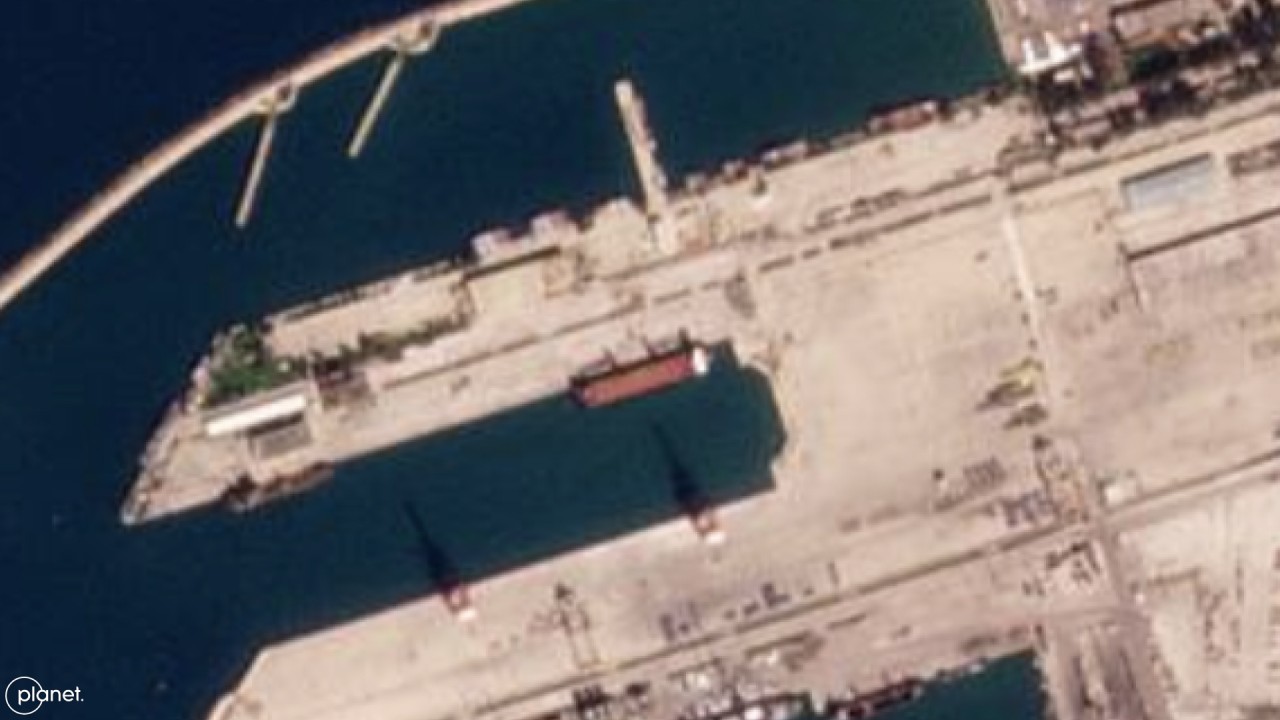 URSA MAJOR (IMO 9538892) at Tartus Port, Syria.
URSA MAJOR (IMO 9538892) at Tartus Port, Syria.From Pulse by SynMax
SynMax will use its artificial intelligence technology combined with Planet’s satellite data to support maritime tracking of illegal fishing, illicit ship-to-ship transfers, and vessel spoofing via a new vessel tracking product called Project Theia.
Since November 2023, SynMax’s maritime domain awareness platform, Theia, has detected, attributed, and tracked the locations of three Russian-flagged vessels: the general cargo ships URSA MAJOR (IMO 9538892) and SPARTA IV (IMO 9743033) and the oil/ chemical tanker YAZ (IMO 9735323).
The SPARTA IV is owned by SC South LLC, a Russian Ministry of Defense shipping company subsidiary.
The UK, Ukraine, and the US have sanctioned the vessels for “delivering maritime goods on behalf of the Russian Ministry of Defence.”
As a result of Russia’s involvement in the Syrian civil war, a significant quantity of Russian heavy military equipment is located in Syria.
As the Ukrainian war drags on, Russia’s equipment shortfalls have necessitated the mass transportation of military equipment from Syria to Sevastopol, Crimea, which is the closest port to the frontlines under Russian control.
Unfortunately for Russia, at the request of Ukraine, Turkey exercised the 1936 Montreux Convention on the 28th of February, 2022, banning Russian warships from entering the Black Sea via the Bosphorus and Dardanelles straits.
This was later revised to allow Russian warships access if they were returning to a home port in the Black Sea, but it left a significant shortfall between Russia’s transport capabilities and its requirements.
As a result, Russia has utilized vessels in its civilian fleet to transport military equipment, including the URSA MAJOR, SPARTA IV, and YAZ.
A Royal United Services Institute (RUSI Europe) report has claimed that the SPARTA IV “serves as an auxiliary vessel for the Russian military.” As such, it could be argued that Russia is acting in contravention of the Montreux Convention.
Ukraine is confident that the SPARTA IV is a Russian military transport, so much so that they unsuccessfully attempted to attack the ship with an uncrewed surface vessel (USV) on the 4th of August, 2023.
Theia collected imagery of the vessels transiting from Novorossiysk Port, Russia, to Tartus military port, Syria, through the Bosphorus and Dardanelles straits.
Theia detected and attributed the URSA MAJOR AIS dark at a military berth in Novorossiysk Port on the 10th of November, 2023.
The URSA MAJOR remained dark, transiting across the Black Sea until the 3rd of December 2023, when she began emitting AIS transmissions at the mouth of the Bosphorus Strait.
The URSA MAJOR continued to transmit while transiting through the Bosphorus and Dardanelles Straits, turning off her AIS before entering the Mediterranean.
She remained AIS dark for a further three months.
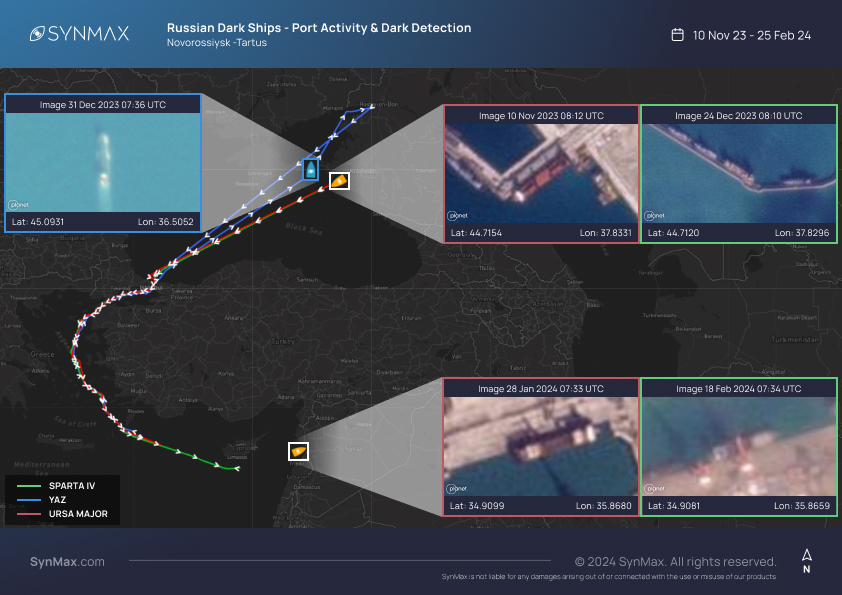
The SPARTA IV was sighted at the same military berth at Novorossiysk Port on the 24th of December, 2023, before she carried out the same AIS dark journey across the Black Sea to reappear at the mouth of the Bosphorus Strait on the 28th of December, 2023.
It is assessed that the vessels turned off their AIS to avoid the Ukrainian drone threat faced by Russian ships in the Black Sea, and again in the Mediterranean to hide their destination- Tartus Port.
Theia observed the URSA MAJOR and SPARTA IV AIS dark, transferring cargo in Tartus Port.
On the 24th of February, 2024, the YAZ and the SPARTA IV transited north with AIS on for what appeared to be the return journey to Novorossiysk.
On the 26th of February, both vessels approached the entrance to the Bosphorus Strait, pausing for 13 hours before unexpectedly returning south.
It has been suggested that the vessels were deterred by the threat of Ukrainian USVs, which have been responsible for the destruction of multiple Russian warships, including the SERGEY KOTOV on the 4th of March, and resulted in the dismissal of Adm Nikolai Yevmenov, ex-Commander of the Russian Navy.
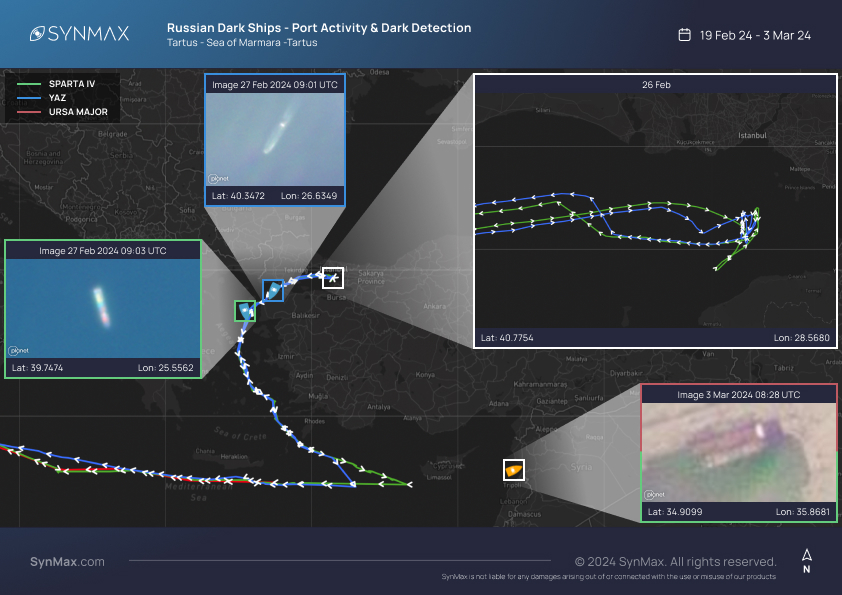
On the 3rd of March, the AIS dark URSA MAJOR and SPARTA IV were detected at Tartus Port, imaged alongside one another.
The URSA MAJOR was assessed to have concluded her cargo transfer.
On the 5th of March, the URSA MAJOR, SPARTA IV, and YAZ resumed AIS transmissions, making their way across the Mediterranean, transiting through the Strait of Gibraltar before continuing through the English Channel, North Sea, and Baltic Sea.
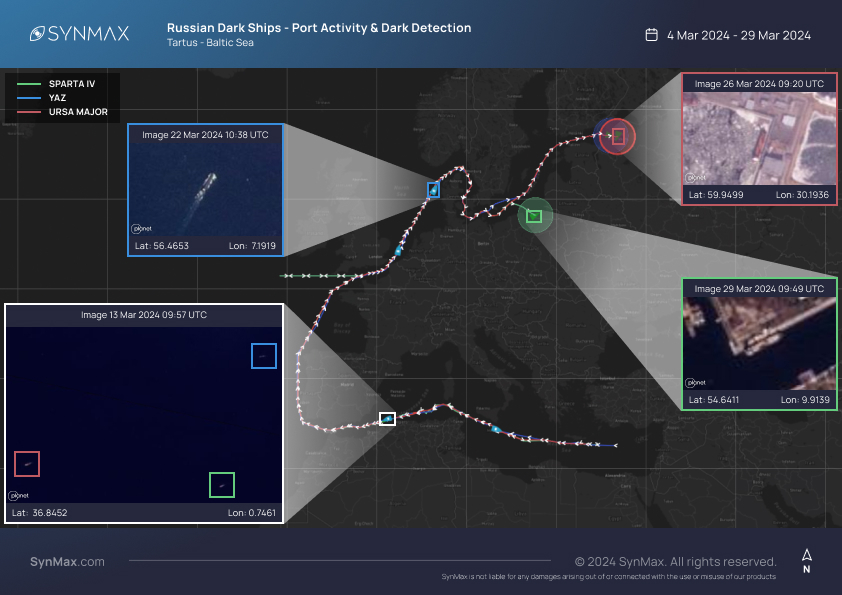
The SPARTA IV arrived in Baltiysk, Russia, on the 22nd of March.
At 19:50 UTC, she came alongside a civilian cargo berth before turning off her AIS at 21:30 UTC.
Despite this being the apparent conclusion to her journey, Theia detected the SPARTA IV engaging in loading/ unloading activity at a military berth on the 29th of March.
The URSA MAJOR arrived at an anchorage 50km from St Petersburg, Russia, on the 23rd of March before transiting to Mpp Bol’shoy customs port, St Petersburg, where she remains.
The YAZ arrived at the same anchorage as the URSA MAJOR, 50km from St Petersburg, on the 27th of March at 10:28 before turning off her AIS at 15:46 UTC.
During the same reporting period, Theia identified two other vessels engaging in similar activity.
Russian flagged Ro-Ro vessels, the BALTIC LEADER (IMO: 9220639) and the LADY MARIIA (IMO: 9220641), were captured at Novorossiysk alongside the SPARTA IV on the 3rd of February 2024.
The LADY MARIIA was detected again as she came alongside the URSA MAJOR and SPARTA IV at Tartus military port on 18th February.
The LADY MARIIA was AIS dark at the time of detection, although she didn’t adopt the same AIS tactics as the URSA MAJOR and SPARTA IV during their voyages to Tartus.
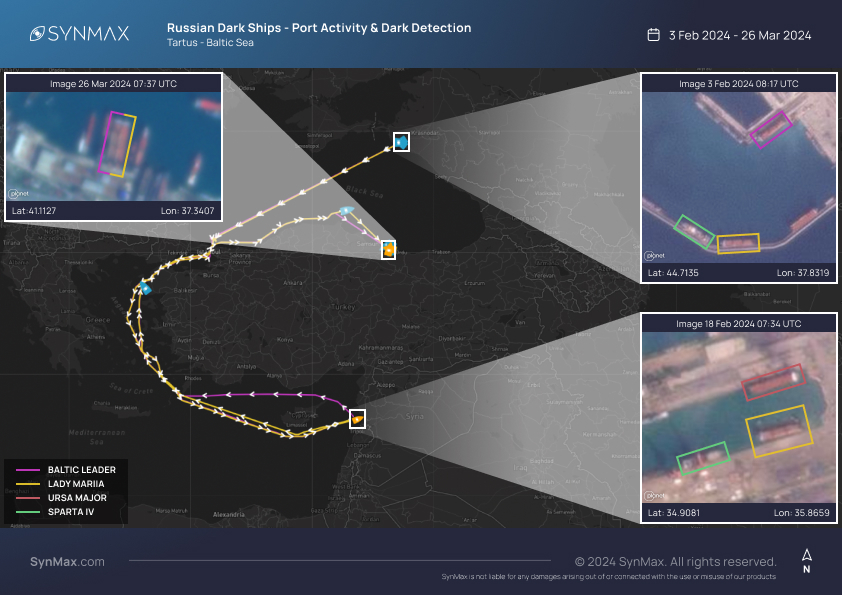
At 19:50 UTC, she came alongside a civilian cargo berth before turning off her AIS at 21:30 UTC.
Despite this being the apparent conclusion to her journey, Theia detected the SPARTA IV engaging in loading/ unloading activity at a military berth on the 29th of March.
The URSA MAJOR arrived at an anchorage 50km from St Petersburg, Russia, on the 23rd of March before transiting to Mpp Bol’shoy customs port, St Petersburg, where she remains.
The YAZ arrived at the same anchorage as the URSA MAJOR, 50km from St Petersburg, on the 27th of March at 10:28 before turning off her AIS at 15:46 UTC.
During the same reporting period, Theia identified two other vessels engaging in similar activity.
Russian flagged Ro-Ro vessels, the BALTIC LEADER (IMO: 9220639) and the LADY MARIIA (IMO: 9220641), were captured at Novorossiysk alongside the SPARTA IV on the 3rd of February 2024.
The LADY MARIIA was detected again as she came alongside the URSA MAJOR and SPARTA IV at Tartus military port on 18th February.
The LADY MARIIA was AIS dark at the time of detection, although she didn’t adopt the same AIS tactics as the URSA MAJOR and SPARTA IV during their voyages to Tartus.

Unlike the URSA MAJOR and SPARTA IV, both vessels sailed to Unye Port, Turkey, where they remain.
Theia specializes in data fusion.
Ingesting Automatic Identification System (AIS) data and 20,000,000 km2 of electro-optical imagery daily, Theia’s proprietary AI extracts actionable intelligence from the terabytes of data, producing genuinely scalable, automatic maritime surveillance.
Theia’s extensive imagery archives mean that regardless of when a vessel raises red flags or suspicions, its past activity can be proven conclusively.
Imagery ties a ship to a specific time and a place with a certainty that synthetic dots on a map cannot replicate.
Without AI analysis of millions of square kilometers of satellite imagery, these detections would not have been possible without a significant expenditure of person-hours.
Instead, SynMax's analysts spend minutes verifying.
Data fusion is the key to understanding big intelligence problems.
AI is a powerful tool for investigators to make sense of big data, significantly scaling up analysts' reach and understanding.
Links :
- Smart Maritime Network : Planet Labs partners with SynMax on ‘dark vessel’ monitoring
Synmax : The Inception of Russia’s LNG Ghost Fleet
ReplyDelete